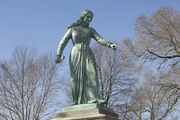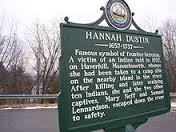Hannah Emerson Dustin was born 23 December 1657 in Haverhill, Essex County, Massachusetts, United States to Michael Emerson (1627-1709) and Hannah Webster (1635-1708) and died 6 March 1738 Haverhill, Essex County, Massachusetts of unspecified causes. She married Thomas Dustin (1652-1732) 3 December 1677 in Essex County, Massachusetts.
Hannah Dustin - Famous Early American Indian Fighter - First Female American to get a Memorial Statue
Biography

Hannah Duston Memorial in Haverhill, MA
Hannah Duston (Dustin, Dustan, and Durstan) (born Hannah Emerson, December 23, 1657 – c. 1736) was a colonial Massachusetts Puritan mother of nine who was taken captive, with her newborn daughter, by Abenaki Native Americans during King William's War, during the Raid on Haverhill (1697), in which 27 colonists were killed. While detained on an island in the Merrimack River in present-day Boscawen, New Hampshire, she killed and scalped ten of the Native American family members holding them hostage, with the assistance of two other captives.
Duston's captivity narrative became famous more than 100 years after she died. Duston is the first woman honored in the United States with a statue. During the 19th century, she was referred to as "a folk hero" and the "mother of the American tradition of scalp hunting". At the same time, scholars assert Duston's story only became legend in the 19th century because America used her story to define its violence against native Americans as innocent, defensive and virtuous.
1697 Raid on Haverhill
During King William's War, Hannah, her husband Thomas and their nine children were residents of Haverhill, Massachusetts in March 1697 when the town was attacked by a group of Abenaki Native American from Quebec. (In this attack, 27 colonists were killed and 13 were taken captive to be either adopted or held as hostages for the French.) When their farm was attacked, Thomas fled with eight children, but Hannah, her newborn daughter Martha, and her nurse Mary Neff (nee Corliss) were captured and forced to march into the wilderness. According to Cotton Mather's account, along the way, the Native Americans killed the six-day-old Martha by smashing her against a tree. Modern Abanaki representatives claim this is unlikely.
Hannah and Mary were assigned to a Native American family group of 13 persons and taken north. The group included Samuel Lennardson, a 14-year-old captured in Worcester, Massachusetts the year before.

Hannah Duston Memorial at Boscowen, NH.
Six weeks later, at an island in the Merrimack River at the mouth of the Contoocook River near what is now Penacook, New Hampshire, Hannah led Mary and Samuel in a revolt. She used a tomahawk to attack the sleeping Native Americans, killing one of the two grown men (Lennardson killed the second), two adult women, and six children. One severely wounded Native American woman and a young boy managed to escape the attack.
The former captives immediately left in a canoe, but not before taking scalps from the dead as proof of the incident and to collect a bounty. They traveled down the river only during the night and after several days reached Haverhill. The Massachusetts General Court later gave them a reward for killing Native Americans; Hannah Duston received 25 pounds, and Neff and Lennardson split another 25 pounds (various accounts say 50 or 25 pounds, and some accounts mention only Duston's receiving an award).
Hannah lived for nearly 40 more years.
Hannah Duston Memorials
- The first memorial that was actually executed was by sculptor William Andrews, a marble worker from Lowell, and erected in 1874 on the island in Boscawen, New Hampshire where she killed her captors. Huge crowds overwhelmed the island on the day of its dedication, with speeches presented all day long. It was the first publicly funded statue in New Hampshire.
- In 1879, a bronze statue of Hannah Duston grasping a tomahawk was created by Calvin H. Weeks (1834–1907) in Haverhill town square (now Grand Army Park), where it still stands. The monument stands on the site of the Second Church, of which Hannah Duston became a member in 1724. The original small axe or hatchet held by Hannah Duston can be found today in the Haverhill Historical Society. The Duston hatchet is not a tomahawk. It is usually called a biscayan or biscayenne, a common trade item of the late seventeenth-century New England frontier.
- The third Memorial was created in 1908 when there was an inscription put on a boulder in Memorial to both Hannah and Martha. The boulder was placed on the site of Hannah's son Jonathan's home, where Hannah lived her final years. Hannah Duston died at this location in 1736.
- Fourth Memorial: A mill stone placed on the shores of the Merrimack River where Hannah, Mary and Samuel beached their canoe upon their return to Haverhill.
- Fifth Memorial: The Site of James Lovewell's Home, where Hannah, Mary and Samuel rested on their way home from captivity.
- Other commemorations include: Hannah Dustin Health Care Center, a Hannah Dustin Rest Home, and a Hannah Dustin Elementary School,
The Dustin House, in which she lived in the years after the raid, is listed on the U.S. National Register of Historic Places.
Family of Thomas and Hannah Duston
Emerson was the oldest of the 15 children born to her parents. At age 20, she married Thomas Duston, a local bricklayer and farmer. The Emerson family had previously been the subject of attention when Elizabeth Emerson, Hannah's younger sister, was hanged for infanticide.
- Hannah Dustin (1678-1732) - md Daniel Cheney
- Elizabeth Dustin (1680-1746)
- Nathaniel Duston (1685-1764)
- Mary Dustin (1681-1696)
- John Duston (1686-1690)
- Sarah Dustin (1688-1759)
- Abigail Dustin (1690-1727)
- Jonathan Dustin (1691-)
- Mehitable Dustin (1694-)
- Timothy Dustin (1694-1775)
- Martha Duston (1697-1697) - Baby killed in 1697 Haverhill Indian Raid
- Lydia Duston (1698-1764)
Children
| Name | Birth | Death | Joined with |
| Hannah Dustin (1678-1732) | 22 August 1678 Haverhill, Essex County, Massachusetts | 27 November 1768 Newbury, Essex County, Massachusetts | Daniel Cheney (1670-1755) |
| Elizabeth Dustin (1680-1746) | 7 May 1680 Haverhill, Essex County, Massachusetts | 4 January 1746 Haverhill, Essex County, Massachusetts | Stephen Emerson (1674-1758) |
| Nathaniel Duston (1685-1764) | |||
| Mary Dustin (1681-1696) | |||
| John Duston (1686-1690) | |||
| Sarah Dustin (1688-1759) | |||
| Abigail Dustin (1690-1727) | |||
| Jonathan Dustin (1692-1757) | 15 January 1692 Haverhill, Essex County, Massachusetts | 28 December 1757 Salem, Rockingham County, New Hampshire | Elizabeth Watts (1689-1721) Sarah Pattee (1712-1769) |
| Mehitable Dustin (1694-) | |||
| Timothy Dustin (1694-1775) | 14 September 1694 Haverhill, Essex County, Massachusetts | 1775 Haverhill, Essex County, Massachusetts | Sarah Johnson (1695-1735) |
| Martha Duston (1697-1697) | |||
| Lydia Duston (1698-1764) | |||
Siblings
| Name | Birth | Death | Joined with |
| Hanna Emerson (1657-1738) | 23 December 1657 Haverhill, Essex County, Massachusetts, United States | 6 March 1738 Haverhill, Essex County, Massachusetts | Thomas Dustin (1652-1732) |
| John Emerson (1659-1659) | |||
| Mary Emerson (1660-1683) | |||
| John Emerson (1662-) | |||
| Samuel Emerson (1664-) | |||
| Jonathan Emerson (1670-) | |||
References
Residences
Footnotes (including sources)
| This page uses content from the English language Wikipedia. The original content was at Hannah Duston. The list of authors can be seen in the page history. As with this Familypedia wiki, the content of Wikipedia is available under the Creative Commons License. |
]